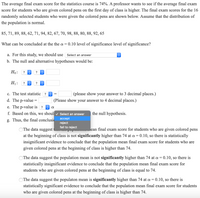
MATLAB: An Introduction with Applications
6th Edition
ISBN: 9781119256830
Author: Amos Gilat
Publisher: John Wiley & Sons Inc
expand_more
expand_more
format_list_bulleted
Concept explainers
Topic Video
Question
need help with B, C, D

Transcribed Image Text:**Educational Website Text: Statistical Analysis of Exam Scores**
**Context:**
The purpose of this study is to assess whether providing colored pens to students on the first day of class influences their final exam scores in a statistics course. The course's average final score is known to be 74%, and a professor aims to determine if the average score increases with the provision of colored pens. Here are the scores for 16 students who received colored pens:
**Scores:**
85, 71, 89, 88, 62, 71, 94, 82, 67, 70, 98, 88, 80, 88, 92, 65
**Statistical Analysis:**
**Objective:**
To evaluate at a significance level (\(\alpha = 0.10\)), whether the average final score for students who received colored pens is significantly higher than 74.
**Steps:**
- **a. Level of Significance:**
For this study, select the correct level of significance.
- **b. Hypotheses:**
- \(H_0\): (Null Hypothesis) The mean score is equal to 74.
- \(H_1\): (Alternative Hypothesis) The mean score is greater than 74.
- **c. Test Statistic:**
Calculate and enter the test statistic to three decimal places.
- **d. P-value:**
Determine and provide the p-value to four decimal places.
- **e. P-value vs. \(\alpha\):**
Compare the p-value with \(\alpha = 0.10\).
- **f. Decision on Null Hypothesis:**
Based on the above, decide to accept or reject the null hypothesis.
- **g. Conclusion:**
Use the findings to conclude:
- Option 1: The data suggest that the population mean final exam score for students who use colored pens is not significantly higher than 74.
- Option 2: The data suggest the population mean is not significantly higher than 74; hence, no evidence supports a higher mean.
- Option 3: The data suggest the population mean is significantly higher than 74, supporting the effectiveness of colored pens.
This analysis helps evaluate the potential impact of colored pens on student performance, based on statistical evidence.
Expert Solution
This question has been solved!
Explore an expertly crafted, step-by-step solution for a thorough understanding of key concepts.
Step by stepSolved in 2 steps with 1 images

Knowledge Booster
Learn more about
Need a deep-dive on the concept behind this application? Look no further. Learn more about this topic, statistics and related others by exploring similar questions and additional content below.Similar questions
Recommended textbooks for you
 MATLAB: An Introduction with ApplicationsStatisticsISBN:9781119256830Author:Amos GilatPublisher:John Wiley & Sons Inc
MATLAB: An Introduction with ApplicationsStatisticsISBN:9781119256830Author:Amos GilatPublisher:John Wiley & Sons Inc Probability and Statistics for Engineering and th...StatisticsISBN:9781305251809Author:Jay L. DevorePublisher:Cengage Learning
Probability and Statistics for Engineering and th...StatisticsISBN:9781305251809Author:Jay L. DevorePublisher:Cengage Learning Statistics for The Behavioral Sciences (MindTap C...StatisticsISBN:9781305504912Author:Frederick J Gravetter, Larry B. WallnauPublisher:Cengage Learning
Statistics for The Behavioral Sciences (MindTap C...StatisticsISBN:9781305504912Author:Frederick J Gravetter, Larry B. WallnauPublisher:Cengage Learning Elementary Statistics: Picturing the World (7th E...StatisticsISBN:9780134683416Author:Ron Larson, Betsy FarberPublisher:PEARSON
Elementary Statistics: Picturing the World (7th E...StatisticsISBN:9780134683416Author:Ron Larson, Betsy FarberPublisher:PEARSON The Basic Practice of StatisticsStatisticsISBN:9781319042578Author:David S. Moore, William I. Notz, Michael A. FlignerPublisher:W. H. Freeman
The Basic Practice of StatisticsStatisticsISBN:9781319042578Author:David S. Moore, William I. Notz, Michael A. FlignerPublisher:W. H. Freeman Introduction to the Practice of StatisticsStatisticsISBN:9781319013387Author:David S. Moore, George P. McCabe, Bruce A. CraigPublisher:W. H. Freeman
Introduction to the Practice of StatisticsStatisticsISBN:9781319013387Author:David S. Moore, George P. McCabe, Bruce A. CraigPublisher:W. H. Freeman

MATLAB: An Introduction with Applications
Statistics
ISBN:9781119256830
Author:Amos Gilat
Publisher:John Wiley & Sons Inc

Probability and Statistics for Engineering and th...
Statistics
ISBN:9781305251809
Author:Jay L. Devore
Publisher:Cengage Learning

Statistics for The Behavioral Sciences (MindTap C...
Statistics
ISBN:9781305504912
Author:Frederick J Gravetter, Larry B. Wallnau
Publisher:Cengage Learning

Elementary Statistics: Picturing the World (7th E...
Statistics
ISBN:9780134683416
Author:Ron Larson, Betsy Farber
Publisher:PEARSON

The Basic Practice of Statistics
Statistics
ISBN:9781319042578
Author:David S. Moore, William I. Notz, Michael A. Fligner
Publisher:W. H. Freeman

Introduction to the Practice of Statistics
Statistics
ISBN:9781319013387
Author:David S. Moore, George P. McCabe, Bruce A. Craig
Publisher:W. H. Freeman